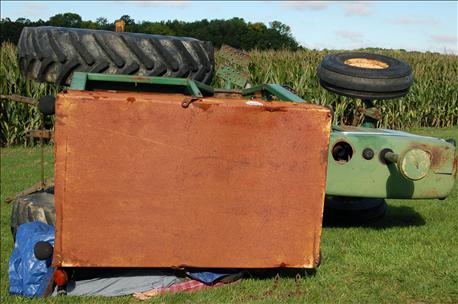
One farm fatality is one too many. Yet from 1980 through 2015, 955 Hoosiers have died in farm-related accidents. That’s the total in a recent report of farm fatalities released by safety specialist Bill Field and co-workers at Purdue University.
Field’s challenge is bringing the number of people killed in farm accidents down to zero. He’s made progress over time. The trend over the past several decades is definitely fewer farm fatalities.
Nevertheless, the Purdue study documents 28 farm-related accident fatalities in 2015. “Those are the ones we know about,” Field says. “There could be others. There is not a standardized system for reporting farm-related accidents in Indiana.”

TRACTOR OVERTURNS REMAIN BIG ISSUE: Tractor overturns have accounted for the overwhelming majority of farm-related deaths over the past 50 years. Take precautions when operating tractors.
Fatalities by county
A list no county wants to be on is the list of the most farm fatalities by county over the past 36 years. Of the 955 total deaths in Indiana beginning in 1980, Field knows where 882 occurred. It’s wasn’t possible to pinpoint where the other 73 people died, he adds.
The top eight counties with the most farm fatalities from 1980 through 2015, and the number of fatalities, respectively, are: Elkhart, 30; LaGrange, 28; Greene, 23; Dubois, 19; St. Joseph, 18: Adams, 17; Franklin, 17; and Harrison, 15.
Elkhart and LaGrange counties are home to the state’s largest Amish population, Field notes. Those communities have historically accounted for a disproportionate share of farm-related fatalities. He notes that in one recent annual survey, this population accounted for about one-third of all documented deaths.
However, counties with the most farm fatalities over time isn't the only thing that stands out when looking at a map of where farm deaths occur, Field notes. “No county has escaped a farm fatality,” he says.
In fact, seven fatalities have been reported over this period in Marion County, the most highly populated urban county in the state. Allen County, home of Fort Wayne but also home to a significant Amish population in the rural areas, has recorded 14 farm fatalities from 1980 through 2015.
Tractor overturns
While it doesn’t always get the most attention, tractor overturns remain the single biggest cause of farm fatalities, Field says. Some of the counties on the list for most fatalities have a large amount of sloping land. Yet whether there is a correlation may be difficult to prove. Madison County reported 13 deaths, and Delaware County reported 11. Neither is known for an abundant amount of rolling land or steep hills.
In 2015, 39% of the 28 farm fatalities involved tractors, and nearly all were related to an overturn, Field says. Also on the 2015 list are two cases where a self-propelled lawn mower overturned. Two more incidents involved ATVs, although it’s not clear if an overturn was the cause.
Make sure tractors are equipped with Rollover Protective Structures — and use common sense, Field says. That's still the best way to prevent farm fatalities.
About the Author(s)
You May Also Like




